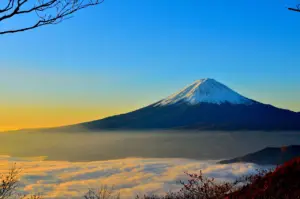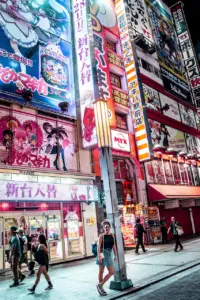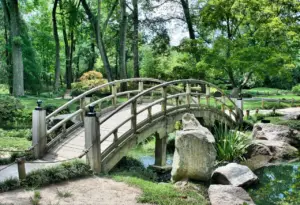Are you looking for a peaceful escape from the hustle and bustle of modern life? Japan’s traditional tea houses may be just what you need. These tranquil retreats have a long history and offer a unique cultural experience that will leave you feeling refreshed and rejuvenated.
Japanese tea houses, also known as chashitsu, have been around for centuries and are deeply rooted in Japanese culture. They were originally used as places for tea ceremonies, which are a formal and highly ritualistic practice that involves serving and drinking tea.
Today, tea houses serve as quiet havens where you can relax and enjoy a cup of tea while surrounded by the beauty of traditional Japanese architecture and gardens. In this article, we will explore the history of Japanese tea houses, the different types of tea houses, the tea ceremony, the architecture and gardens of tea houses, as well as the etiquette and cuisine associated with these peaceful retreats.
Key Takeaways
- Tea houses in Japan have a long history and are deeply rooted in Japanese culture, originally used for tea ceremonies.
- Tea house architecture and gardens create a peaceful and inviting atmosphere, allowing visitors to escape from the stresses of daily life.
- Tea house cuisine is a blend of traditional Japanese dishes and modern creations, perfectly complementing the delicate flavors of the tea.
- Proper etiquette is important during tea ceremonies, including being punctual, dressing appropriately, and remaining quiet and respectful.
History of Japanese Tea Houses
You might be surprised to learn that the history of Japanese tea houses dates back to the 16th century. It was during this period that the tea ceremony, or Chanoyu, became an essential part of Japanese culture.
Tea houses were created as a tranquil and peaceful retreat, where people could escape from the stresses of daily life and enjoy the simple pleasures of tea.
Originally, tea houses were used as a place for the Samurai to gather and discuss important matters. Over time, the practice of drinking tea became more widespread, and tea houses began to pop up all over Japan.
They were designed to be minimalist in style, with traditional tatami mats, shoji screens, and low tables. The aim was to create a peaceful and calming ambiance, where people could focus on the tea and appreciate the beauty of their surroundings.
Types of Tea Houses
There are different kinds of establishments that cater to those seeking a peaceful respite from the hustle and bustle of daily life in Japan. Here are some of the most popular types of tea houses:
-
Chashitsu – These’re traditional tea houses designed to provide a serene and meditative atmosphere for tea ceremonies. They’re usually located in gardens or parks and are often surrounded by a peaceful landscape.
-
Kissaten – These’re coffee shops that serve tea and other drinks as well. They’re more modern than chashitsu and often have a more casual atmosphere.
-
Ryokan – These’re traditional Japanese inns that often have a tea room or tea garden for guests to enjoy. They’re usually located in scenic areas, such as hot springs or mountains.
-
Yakatabune – These’re small boats that are used for tea ceremonies and other events. They offer stunning views of the surrounding scenery and are a unique way to experience Japanese tea culture.
Tea Ceremony
When you attend a tea ceremony, be prepared to sit on your knees for an extended period and savor the delicate flavors of the tea.
The tea ceremony, also known as chanoyu, is a Japanese cultural activity that involves the ceremonial preparation and presentation of matcha, a powdered green tea. It is a highly choreographed and formal ritual that has been practiced for centuries in Japan.
During the tea ceremony, the tea master will use a bamboo whisk to mix the matcha with hot water in a ceramic bowl. The bowl is then passed around to each guest, who takes a sip and admires the patterns in the tea foam.
The tea is accompanied by a sweet treat, which is carefully chosen to complement the flavor of the tea. The tea ceremony is not just about drinking tea, but also about experiencing a moment of tranquility and mindfulness, and appreciating the beauty of simplicity.
Tea House Architecture
As you step into a Japanese tea house, you’ll immediately notice the unique elements of Japanese architecture that make it stand out from other buildings.
From the low, simple entrance to the use of natural materials like wood and paper, every aspect of the design is carefully crafted to create a peaceful and harmonious atmosphere.
The layout of the tea house is also carefully planned, with different areas designated for specific activities like preparing the tea and enjoying it with guests.
Elements of Japanese Architecture
Japanese architecture incorporates unique elements that are essential to the design of traditional tea houses, creating tranquil retreats in the evening. Firstly, the use of natural materials such as wood, paper, and bamboo is a defining feature of Japanese architecture. These materials are carefully selected and arranged to create a sense of harmony and balance between the interior and exterior of the tea house.
Secondly, the use of sliding doors and screens, known as shoji and fusuma, is another important element of Japanese architecture. These doors and screens are not only functional, but also serve as decorative elements, allowing natural light to filter into the tea house while maintaining privacy.
Additionally, the use of tatami mats on the floor creates a comfortable and cozy atmosphere, adding to the overall sense of tranquility in the tea house. These elements work together to create a unique and peaceful environment that’s perfect for relaxing and enjoying a cup of tea.
Design and Layout of Tea Houses
You’ll notice the design and layout of tea houses are carefully thought out to create a peaceful and inviting atmosphere. The entrance to the tea house is intentionally small and low, requiring guests to bow down and enter humbly. This is meant to create a sense of humility and respect for the tea ceremony, as well as to physically separate the guests from the outside world.
Inside the tea house, the tatami mat floor is the centerpiece of the space. The mats are made of woven rice straw and covered in rush or silk. They provide a soft, natural surface for guests to sit on during the tea ceremony.
The walls are typically made of paper or wood panels, allowing for natural light to filter in and creating a warm and inviting feel. The tea house is designed to be a place of quiet contemplation and relaxation, where guests can escape the chaos of the outside world and focus on the present moment.
Tea House Gardens
Amidst the serene tea house gardens, the gentle trickling of water and the soft rustling of leaves create an atmosphere of peace and tranquility. The gardens are an integral part of the tea house experience, as they provide a space for guests to relax and meditate before and after their tea ceremony. The design of the gardens is carefully planned, with elements such as stone paths, bamboo fences, and carefully placed rocks and trees creating a sense of harmony and balance.
In Japanese tea culture, the garden is seen as a reflection of the tea house itself. The table below shows some common elements found in tea house gardens and their symbolic meanings:
| Element | Symbolic Meaning |
|---|---|
| Stone Path | Represents the path to enlightenment |
| Bamboo Fence | Creates a sense of privacy and seclusion |
| Lantern | Illuminates the path towards spiritual awakening |
| Water Basin | Provides a space for guests to purify themselves before entering the tea house |
| Cherry Blossom Tree | Symbolizes the transience of life and the beauty of impermanence |
Whether you are a tea enthusiast or simply looking for a peaceful escape from the hustle and bustle of everyday life, the tea house gardens offer a serene oasis that is sure to leave you feeling refreshed and rejuvenated.
Tea House Etiquette
To fully immerse yourself in the tea house experience, it’s important to understand the proper etiquette when participating in a tea ceremony. First and foremost, it’s essential to arrive on time. Being punctual demonstrates respect for the host and the ceremony.
When entering the tea house, it’s customary to bow and remove your shoes. You should also dress appropriately, avoiding flashy or revealing clothing.
During the ceremony, it’s important to remain quiet and respectful. Avoid fidgeting or speaking unless necessary. When drinking the tea, hold the cup with both hands and take small sips. It’s also customary to admire the tea bowl and its decoration before drinking.
After finishing the tea, you should thank the host and admire the tea utensils before leaving the tea house. By following these guidelines, you can fully appreciate the tranquility and beauty of the tea ceremony.
In addition to the ceremony itself, there are also important rules to follow regarding interactions with other guests. It’s customary to avoid discussing topics related to politics, religion, or other controversial subjects. Instead, focus on the beauty of the tea house and the surrounding nature.
If you need to leave the room during the ceremony, excuse yourself quietly and return as soon as possible. By following these rules of etiquette, you can ensure a peaceful and respectful atmosphere for everyone involved.
Tea House Cuisine
Indulge in a delectable array of savory and sweet treats that perfectly complement the delicate flavors of the tea during your visit to the tea house. As you sit on the tatami mat and sip on your tea, the aroma of the freshly prepared dishes will tantalize your senses. The tea house cuisine is a blend of traditional Japanese dishes and modern creations that will satisfy your cravings.
Start your meal with a selection of small appetizers called ‘zensai,’ which includes dishes like pickled vegetables, grilled fish, and tofu. These light and flavorful bites will prepare your palate for the main course.
For the main dish, try the ‘ochazuke,’ which is a traditional rice dish served with tea poured over it. The tea adds a subtle flavor to the rice, and the dish is usually topped with a variety of ingredients like salmon, seaweed, or pickled plum.
Don’t forget to save room for dessert! End your meal with a sweet treat like ‘wagashi,’ which are traditional Japanese sweets made with ingredients like rice flour, red bean paste, and green tea. These delicate sweets are a perfect way to end your tea house experience.
Tea House Locations
You can easily find tea house locations in many cities around the world, offering a unique cultural experience and a chance to unwind with a cup of tea.
In Japan, tea houses are typically located in serene and tranquil settings, such as gardens or by the river. These locations offer an escape from the hustle and bustle of the city, and allow you to immerse yourself in the peaceful atmosphere of the tea house.
One popular location for tea houses in Japan is Kyoto, where you can find many traditional tea houses along the narrow streets of the Gion district. These tea houses offer a glimpse into Japan’s rich culture and history, through their intricate architecture and tea ceremonies.
Another popular location is Tokyo, where you can find modern tea houses that offer a fusion of traditional and contemporary styles. Whether you’re in the heart of the city or in a quiet neighborhood, a tea house is a perfect place to relax and enjoy the tranquility of Japan’s traditional culture.
Frequently Asked Questions
Are there any modern tea houses in Japan that cater to younger generations?
Yes, there are modern tea houses in Japan that cater to younger generations. These tea houses offer a contemporary twist on the traditional tea ceremony, incorporating new flavors and techniques while still maintaining the essence of the ceremony.
They often feature a more casual atmosphere and may also offer food and drinks beyond tea. These modern tea houses can be found in trendy neighborhoods and are popular among young people looking for a unique and culturally rich experience.
So, if you’re a younger traveler visiting Japan, be sure to check out these modern tea houses and experience the best of both worlds: tradition and innovation.
What are the differences between the tea ceremonies held in tea houses and those held in homes?
When it comes to the differences between tea ceremonies held in tea houses versus those held in homes, it largely comes down to the setting and formality.
Tea ceremonies in tea houses are typically more formal, with guests expected to follow a specific set of customs and etiquette. The setting itself also plays a role, with tea houses being specifically designed to create a calming and peaceful atmosphere.
On the other hand, tea ceremonies in homes can be more casual and relaxed, with the focus on spending time with loved ones and enjoying each other’s company.
Ultimately, both settings offer unique and meaningful experiences, but the formality and atmosphere can vary.
How have tea houses evolved over time to meet the changing needs of society?
Tea houses have evolved over time to meet the changing needs of society. Initially, they were primarily used for tea ceremonies. Over time, they became a place for socializing and relaxation.
Nowadays, tea houses offer a range of services including food and drink, cultural activities, and even accommodation. Some tea houses have also incorporated modern technology and design to attract a younger crowd.
Despite these changes, the traditional aspects of tea ceremony remain at the core of the tea house experience. Attention to detail and mindfulness are still important.
Can foreigners participate in traditional tea ceremonies at tea houses?
Yes, foreigners are welcome to participate in traditional tea ceremonies at tea houses in Japan. However, it’s important to note that these ceremonies follow strict etiquette and protocol. It’s recommended to have a basic understanding of the customs and procedures beforehand.
Many tea houses offer English-speaking hosts or guides who can explain the significance and history of the ceremony, as well as answer any questions. It’s also recommended to make a reservation in advance, as tea ceremonies are often intimate and limited in capacity.
Participating in a traditional tea ceremony can be a unique and immersive cultural experience. It allows you to gain a deeper appreciation for the art and philosophy of tea in Japanese culture.
Are there any famous tea houses in Japan that have been featured in movies or literature?
If you’re looking for famous tea houses in Japan that have been featured in movies or literature, there are a few you might want to check out. One of the most famous is probably Ippodo Tea Co. in Kyoto. It has been around since the 1700s and has been mentioned in several Japanese novels.
Another tea house to visit is Saryo Tsujiri in Kyoto. It has been featured in Japanese films and TV shows.
If you’re a fan of Murakami, you might want to visit the tea house in Nakano, Tokyo that inspired his novel ‘Norwegian Wood.’
And if you’re a fan of Studio Ghibli, you might recognize the real-life inspiration for the Aburaya bathhouse in ‘Spirited Away.’ It is located in Dogo Onsen in Ehime prefecture and features a tea room in addition to its hot springs.
Conclusion
Well done! You’ve learned a lot about Japan’s traditional tea houses. These tranquil retreats have a rich history and offer a unique experience for anyone who visits.
Tea houses come in many different types and styles, each with their own unique features and characteristics. The tea ceremony is an important part of the tea house experience, and the etiquette involved in the ceremony is intricate and precise.
The architecture and gardens of tea houses are also a sight to behold. Each element is meticulously designed to create a peaceful and serene atmosphere. Finally, the delicious cuisine served at tea houses is made to complement the tea and enhance the overall experience.
If you have the opportunity to visit Japan, make sure to visit a traditional tea house. You won’t be disappointed by the rich history, beautiful surroundings, and unique cultural experience. Don’t forget to follow the proper etiquette and enjoy every moment of your visit to these tranquil retreats.













































































